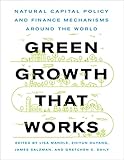Green growth that works : natural capital policy and finance mechanisms around the world / edited by Lisa Mandle, Zhiyun Ouyang, James Salzman, and Gretchen C. Daily.
Contributor(s): Mandle, Lisa | Ouyang, Z. (Zhiyun) | Salzman, James | Daily, Gretchen C
Language: English Publisher: Washington, DC : Island Press, [2019]Description: 1 online resourceContent type: text Media type: computer Carrier type: online resourceISBN: 9781642830033; 1642830038Subject(s): Economic development -- Environmental aspects | Ecosystem management -- Government policy | Environmental policy | Economic development -- Environmental aspects | Ecosystem management -- Government policy | Environmental policyGenre/Form: Electronic books.DDC classification: 333.72 LOC classification: HC79.E5 | G69135 2019Online resources: Full text available at Ebscohost Click here to view| Item type | Current location | Home library | Call number | Status | Date due | Barcode | Item holds |
|---|---|---|---|---|---|---|---|
 EBOOK
EBOOK
|
COLLEGE LIBRARY | COLLEGE LIBRARY | 333.72 (Browse shelf) | Available |
Browsing COLLEGE LIBRARY Shelves Close shelf browser

|

|

|

|

|
No cover image available |

|
||
| 333.714 R242 2021 Risks and the anthropocene: alternative views on the environmental emergency / | 333.714 T739 2011 Environmental impact assessment / | 333.71409914 Ou1 2010 Commentaries on the environmental impact assessment practices / | 333.72 Green growth that works : natural capital policy and finance mechanisms around the world / | 333.72 B5244 2023 Biosphere reserves and sustainable development goals. 2, Issues, tensions, processes and governance in the Mediterranean / | 333.72 C685 1990 Kinaiyahan=nature/ | 333.72 Ec73 2010 Ecological restoration : a global challenge / |
Includes bibliographical references and index.
"[This book] presents the current state of policy and finance tools that allow governments, civil society, and businesses to protect the ecosystem services that make human life possible. Familiar approaches such as government payments, laws and regulations, water funds, and market-based mechanisms can be tailored for specific environmental contexts. The book features case studies that demonstrate how these tools are being used around the world to promote new sources of capital growth that make economic, environmental, and social sense." -- Back cover.
Rapid economic development has been a boon to human well-being. It has lifted millions out of poverty, raised standards of living, and increased life expectancies. But economic development comes at a significant cost to natural capital—the fertile soils, forests, coastal marshes, farmland—that support all life on earth, including our own. The dilemma of our times is to figure out how to improve the human condition without destroying nature's. If ecosystems collapse, so eventually will human civilization. One answer is inclusive green growth—the efficient use of natural resources. Inclusive green growth minimizes pollution and strengthens communities against natural disasters while reducing poverty through improved access to health, education, and services. Its genius lies in working with nature rather than against it. Green Growth That Works is the first practical guide to bring together pragmatic finance and policy tools that can make investment in natural capital both attractive and commonplace. The authors present six mechanisms that demonstrate a range of approaches used around the globe to conserve and restore earth's myriad ecosystems, including: Government subsidies Regulatory-driven mitigation Voluntary conservation Water funds Market-based transactions Bilateral and multilateral payments Through a series of real-world case studies, the book addresses questions such as: How can we channel economic incentives to make conservation and restoration desirable? What approaches have worked best? How can governments, businesses, NGOs, and individuals work together successfully? Pioneered by leading scholars from the Natural Capital Project, this valuable compendium of proven techniques can guide agencies and organizations eager to make green growth work anywhere in the world.

There are no comments for this item.